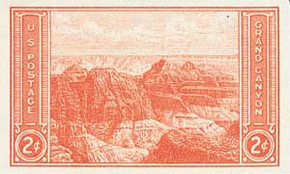
U.S. #759
1935 4¢ Mesa Verde
Special Printing – Issued Imperforate without Gum
Issue Date: March 15, 1935
First City: Washington, DC
Quantity Issued: 1,822,684
Mesa Verde National Park
On June 29, 1906, President Theodore Roosevelt established Mesa Verde National Park, the first American park created to “preserve the works of man.”
Nomadic Paleo-Indians of the Clovis and Folsom cultures were the first known people in the Mesa Verde region dating back to about 9500 BCE. They hunted large animals and set up temporary camps near waterways until the glaciers receded and they dried up.
Around 6000 BCE, the Archaic era began. While they were still nomadic, the people of this era began harvesting a larger variety of plants and created rock shelters. Around 1000 BCE, the first permanent settlements began to appear in the Mesa Verde, marking the start of the basket maker culture. This period saw an increase in farming, particularly of corn and later beans.
The first Pueblo period began around 750. This era is marked by major architectural changes. It gets its name from the year-round homes they created, known as pueblos. It was also during this era that the residents of Mesa Verde began building intricate stone cliff dwellings.
Cliff dwellers built over 600 homes in sandstone canyon walls and under rock overhangs in the southwestern US between 1000 and 1300 AD. The dwellings were made from hand-shaped limestone blocks, wooden beams, and mortar. The Anasazi Indians may have built these cliff dwellings as a defense against northern tribes.
The cliff dwellings of hand-hewn stone building blocks and adobe mortar had few doors on the ground level. Ladders were used to reach the first roof. Ceilings were made of logs and branches plastered with mortar, and structures were built several stories high.
The majority of alcoves within Mesa Verde are small with only a few small rooms. The notable Cliff Palace was 288 feet long and contained 150 rooms and 23 kivas (ceremonial rooms) and had a population of approximately 100 people. It’s structured much like a modern apartment building. Some sections of Cliff Palace are four stories high.
A great mystery surrounds the cliff dwellings and their builders, who left the area around 1300. The inhabitants left many articles behind, including pottery, weapons, tools, and other artifacts. Some believe that the people fled suddenly because of an attack by an enemy band, a natural disaster, or an extreme drought. Others believe the cliff dwellings were abandoned gradually over a period of more than 100 years.
Trappers and prospectors later discovered the cliffs in the 1800s. In 1873, prospector John Moss brought a photographer to the canyon. His photos helped to bring these mysterious dwellings to the public’s attention. In December 1888, members of the Ute tribe led two cowboys to the Cliff Palace. One of them, Richard Wetherill, gave the palace its name. He and his family and friends collected many of the artifacts they found in the cliff dwellings. One of their guests shipped a large number of items to a museum in Finland, which raised concerns about the protection of the site and its resources.
Virginia McClurg was one of the leading voices in the fight to protect the cliffs, launched a 19-year campaign. She gained the support of the Federation of Women’s Clubs and enlisted 250,000 women to write letters, publish poems, and give speeches on the cause. She also founded the Colorado Cliff Dwellers Association. Her efforts paid off on June 29, 1906, when President Theodore Roosevelt signed the park into law. It was the first park created to “preserve the works of man.” The name Mesa Verde is Spanish for “green table” after the forests of juniper and pinion trees.
Over the years, the site was listed on the National Register of Historic Places and designated a World Heritage Site. In 2015, a magazine named it “the best cultural attraction” in the Western United States.
Click here for more about the park from its National Park Service website.















